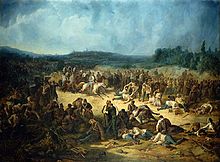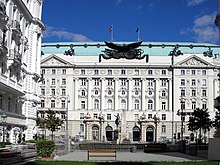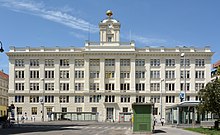Alexander Guran
Alexander Guran , also Alexandru Guran (born May 15, 1824 in Ober-Borlowenj , Caraș-Severin district , † May 18, 1888 in Vienna ) was a Romanian-born kuk field marshal lieutenant , commander of the kuk war school , then head of the 5th department of the kuk war ministry and finally head of the Kuk Military Geography Institute . He was also a recognized painter .
biography
Early years
The son of the commander of the Romanian border regiment No. 13, Lieutenant Colonel Moise Guran, attended schools in his home village, then in Bozovici and finally in Caransebeş . He entered the Theresian Military Academy in Wiener Neustadt on October 29, 1836 , became a sub-lieutenant on September 29, 1843 when he was transferred to the higher course of this institution, and on September 30, 1844 as a lieutenant in the Archduke Franz Ferdinand d'Este Infantry Regiment No. 32 assigned, became first lieutenant there on August 20, 1848 and took part in the campaigns of 1848/49 in Italy, where he particularly distinguished himself in the battles of Governolo , Montanara, Curtatone and the battle of Novara . Because of his military virtues, he was made captain 2nd class on December 1, 1850 , then transferred to quartermaster staff on January 24, 1851 , and promoted to 1st class captain on February 20, 1852.
On May 1, 1859, he was appointed major . In the war of 1859, at the headquarters of the 2nd Army, Guran participated in the battles of Magenta and Solferino during the Sardinian War and received the expression of the Most High Commendation for his achievements in the campaign of the year on June 27, 1859 .
In high offices
Guran was promoted with rank of March 29, 1864 to lieutenant colonel of the quartermaster staff in the corps and with rank of July 5, 1866 in addition to the rank tour to colonel in the general staff. In this position he served as chief of staff at the military command in the Austrian coastal region during the Italian campaign , and then as interim chief of staff in the southern army. After the end of the campaign, on September 26, 1866, he took over command of the Austro-Hungarian War School and the military-administrative training institute until he was promoted to head of the 5th Department of the Austro-Hungarian War Ministry on January 3, 1869. He held this position until October 31, 1872.
After he had been appointed commander of the 1st Infantry Brigade of the 6th Infantry Troops Division on November 1, 1872, which he was to head for four years, and director of the Topography Section in Croatia and Slavonia , the officer moved on April 23, 1873 ( Rank from May 1st of the year) to major general .
In 1876 he was appointed head of the Austro-Hungarian Military Geography Institute. In this capacity, the major general participated in an outstanding manner in the publication of the large new special map of the Austro-Hungarian monarchy as well as in numerous other large and small cartographic works. In 1877, the Chief of the General Staff, Lieutenant Field Marshal Anton Maria Freiherr von Schönfeld , not only vehemently defended him against complaints from the military-technical military committee about the production methods of the new maps , but even praised him for his performance. As a sign of recognition, Emperor Franz Joseph I promoted the general to field marshal lieutenant on May 1, 1878 (rank of the same day) while still in office.
Due to health concerns, Guran asked for his retirement. This request was granted and he retired on November 1, 1879. In his obituaries, Guran was described as a highly educated, extremely dutiful general who was highly respected in the army.
The artist
As a painter, Guran set his creative focus on landscapes and flowers, where he played skillfully with nuances of the colors green, blue, white and yellow. The wooded hills and blooming orchards of his paintings are reminiscent of the places of his childhood. But he also liked to make portraits of people around him. One of his paintings that gained notoriety and prestige was “The Woman with the Lighted Candle” (“Femeia cu lumânare aprinsă”).
As a connoisseur of the human soul, he realized portraits of great expressiveness, the painting mentioned above, which shows a woman in Romanian costume leaving her house in the middle of the night, was most appreciated. She holds a burning candle in one hand while trying to protect the flame from the wind with the other. The flickering light projects mysterious rays over her chest and arms, with a wonderful shade of the face. The painting was exhibited together with 34 other works on the occasion of an exhibition organized by the diocese of Caransebeş by Bishop Joan Popasu on the day the “Society of Orthodox Women from Caransebeş” (“Societatea Femeilor Ortodoxe din Caransebeş”) was founded on May 1, 1891. It was sold in 1925 for an amount of 250,000 lei.
Alexander Guran also published several short stories in the journal "Familia" by the publicist and member of the Romanian Academy Iosif Vulcan in Oradea , as well as dozens of cultural-political articles in the newspapers "Albina" from Vienna, "Concordia" from Budapest and "Luminătorul" from Timișoara . He was happy about his recognition by King Carol I and the friendships with Bishop John Popasu , Vincențiu Babeș , imperial council politician and co-founder of the Romanian Academy, but also with some boyar families.
Recognized for his artistic sense, he was Austria's delegate to the world exhibition in Paris in 1878 in the field of painting. The general was also chairman of the Austro-Hungarian commission at this exhibition. He was elected honorary president of the "European Painting Exhibition" in Paris three times in a row .
Awards
The general was decorated many times, including the following decorations:
- Knight of the Imperial Austrian Leopold Order (1872)
- Grand Cross of the Imperial Russian Order of Saint Stanislaus
- Grand Cross of the Royal Sardinian Order of St. Mauritius and Lazarus
- Grand Cross of the Royal Romanian Order of the Star of Romania
- Grand Commander of the Imperial Persian Order of the Sun and Lions
Individual evidence
- ↑ a b c d Militär-Zeitung No. 37, from Friday, May 25, 1888, p. 298
- ↑ Österreichisch-Ungarische-Reform-Zeitung Vedette No. 43, from Sunday, May 27, 1888, p. 351
- ^ A b c d Johann Svoboda: "The Theresian Military Academy in Wiener-Neustadt and its pupils 1838-1893", Volume 2, KK Hof- und Staatsdruckerei., Vienna 1897, p. 86
- ↑ Military newspaper No. 37, of Wednesday, May 11, 1859, XII. Volume, p. 299
- ↑ K. k. Army Ordinance Gazette, No. 16 of March 24, 1864, KK Hof- und Staatsdruckerei, Vienna 1867, p. 88
- ↑ K. k. Army Ordinance Gazette, No. 28, of June 15, 1866, KK Hof- und Staatsdruckerei, Vienna 1866, p. 243
- ^ A. Graf von Thürheim: "Memorial sheets from the war history of the KK Austrian Army", 2nd volume, Verlag der Buchhandlung für Militärliteratur Karl Prochaska, Vienna and Teschen 1880, p. 444 f.
- ↑ Austrian Academy of Sciences: “Studies on the History of the Austrian-Hungarian Monarchy”, Volumes 10–11, Verlag Böhlau, Vienna 1971, p. 263
- ^ A b c Antonio Schmidt-Brentano: The kk or kuk Generalität 1816–1918, Austrian State Archives, 1907, p. 60
- ↑ Hubert Zeinar : “History of the Austrian General Staff - War of Liberation up to World War I”, Verlag Böhlau GmbH and Co. KG, Vienna - Cologne - Weimar 2006, p. 394
- ↑ a b http://www.banaterra.eu/romana/alexandru-guran
- ↑ http://enciclopediaromaniei.ro/wiki/Alexandru_Guran
- ↑ Archive link ( Memento from October 17, 2014 in the Internet Archive )
literature
- Liviu Groza: “Grănicerii bănăţeni. Pagini din cronica Regimentului de grăniceri din Caransebeş “, Editura Militară, Bucharest 1983
Web links
- Alexander Guran , Romanian
- The Borloveni School , Romanian
| personal data | |
|---|---|
| SURNAME | Guran, Alexander |
| ALTERNATIVE NAMES | Guran, Alexandru |
| BRIEF DESCRIPTION | Austrian officer (field marshal lieutenant), teacher, director of the military academy and head of the Military Geographic Institute and painter |
| DATE OF BIRTH | May 15, 1824 |
| PLACE OF BIRTH | Ober-Borlowenj , Caraș-Severin County |
| DATE OF DEATH | May 18, 1888 |
| Place of death | Vienna |





